World Orchid Conference 2008 |
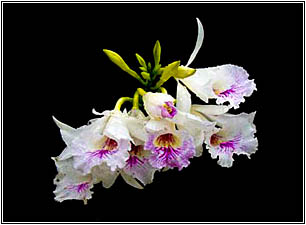 Broughtonia negrilensis var semi-alba ‘Danny Bennett’ (Wild collected plant) |
The genus Broughtonia was first described under the binomial system
of nomenclature, by Dr. Robert Brown of ‘Brownian motion’ fame in
1813 and was named in honor of Arthur Broughton, an English Botanist who had
worked in Jamaica. When the genus was set up, it was comprised of a single species
– Broughtonia sanguinea, which is endemic to the Caribbean island of Jamaica.
In 1961 Jack Fowlie described Broughtonia negrilensis, a species found
only in the south eastern end of Jamaica and vegitatively almost indistinguishable
from Broughtonia sanguinea, except for the color of the foliage, which tens
to be glaucous (bluish). The earliest records available indicate that Broughtonia
sanguinea was first named by Sir Hans Sloane in 1696 as Viscum radice bulbosa
minus, Delphinii flore rubro specioso. According to Withner (1996) the species
was first introduced to Kew Gardens in 1793 by Water Ewer and was one of the
first epiphytic orchids to be cultivated in England. |
The genus Broughtonia is very closely allied to Cattleyopsis and Laeliopsis and
some taxonomists like Dressler (1966) and Adams (1971) have included both Cattleyopsis and Laeliopsis under a single genus Broughtonia.Others like Sauleda
and Adams (1984) and Withner (1996) have chosen to keep them separate. The species has been well known for a long time and was first named by Sir Hans Sloan (1696) prior to the introduction of the binomial system by Lindley. Sloan described it as “with beautiful red flowers like a Larkspur” (Adams, 1971). In 1788 Swartz named the species Epidendrum sanguineum (Withner, 1996) and it was given it’s present name by Robert Brown in 1813 when he set up the genus Broughtonia. The species is quite common in most coastal and some inland areas of the island. It occurs in two markedly different habitats. In the coastal areas it is quite frequently found on trees and scrubland in the dry limestone forests, oftentimes very close to the sea. Here plants tend to grow close to the ground or in pockets of limestone filled with dry leases and twigs and where the humidity is highest. In other areas, mainly inland and especially where rainfall is high, it occurs is large trees such as the Guango (Samanea saman), a giant legume. On these trees it is found high on the tops of the branches, where the plants are able to dry our quickly after rainfall. The flowers of Broughtonia sanguinea are mainly red to a pinkish purple with pronounced veining. Typically plants bear 6 – 20 flowers clustered at the ends of sometimes branched spikes that vary from 20 – 35 inches long. |
 |
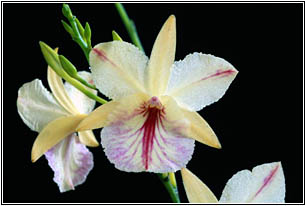 |
Broughtonia sanguinea var alba ‘Mem. Claude H. Hamilton’ AM/AOS |
Broughtonia sanguinea var aquinii aurea 'Sunset' |
 |
 |
Broughtonia. sanguinea 'Peaches' |
Broughtonia sanguinea 'Hamlyn's Peachy' JC-AOS x self |
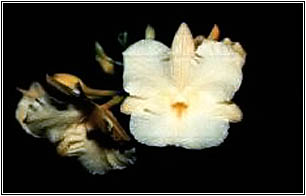 |
Broughtonia sanguinea var aurea 'Hamlyn' AM-AQ-AOS |
Flowers are typically
3.5 – 4.5 cm. wide. The blooms are usually circular in shape, flat with
erect well held petals and sepals and a wide flared lip giving the appearance
of a miniature Cattleya. Plants from the south coastal areas of the island
tend to be lighter coloured, have larger lips, more open form and with more
pronounced veining, than those on the north coastal areas. I suspect that many
of these may be a hybrid swarm with some other species, possibly either Broughtonia
negrilensis or one now extinct. Plants from north coastal areas tend to
branch more frequently and produce secondary and even tertiary branches that
those from south coastal areas. The compact, oftentimes flattened pseudobulbs
bear 1 – 4 fleshy leaves that have smooth margins. The pseudobulbs have
two nodes or flattened scars that encircle them, unlike Laeliposis domingensis where these scars or nodes are markedly raised and the leaf margins erose. There are two main named colour variants. There are the alba variety (white) and the aurea form (yellow). There are a host of other color forms. Most commonly these are in shades of pink to purple but also semi alba, aquinii, peach and several other colors have been found in the wild or produced artificially from seed. The species was first described by Dr. Jack Fowlie in 1961 in The American Orchid Society Bulletin. It was for a long time confused with two other species, Laeliopsis domingensis (Lindley) Lindley a species from the island of Hispaniola, which is separated into Haiti and The Dominican Republic, and Cattleyopsis lindenii (Lindley) Cogniaux from Cuba and the Bahamas. Broughtonia negrilensis Fowlie has also been called Broughtonia lilacina Northrop, a synonym of Laeliopsis domingensis (Lindley) Lindley. Vegitatively, it is almost identical to Broughtonia sanguinea except that the foliage has a dull bluish green coloration which is detectible by experienced growers. The flowers of Broughtonia negrilensis are typically in shades lavender with very pronounced darker veining. The lip is long and trumpet shaped and tightly folded so as to completely encircle the column and much larger than that of Broughtonia sanguinea; the base of the lip has yellowish hairs. Very often the sepals and petals arch slightly forward so as to give a slightly cupped appearance though not nearly as cupped as Laeliopsis domingensis. A white variety is also known but is very rare in cultivation. Because it was confused in the past with Laeliopsis domingensis, many hybrids attributed to the former were actually hybrids of this species. In 1984 Dr. Ruben Sauleda writing in Rhodora (1984) named the natural hybrid Bro. jamaicensis (Bro. sanguinea x Bro. negrilensis) and in 1984 in an article in “The Orchid Digest” he pointed out several differences between Bro. negrilensis and Lps. domingensis. No hybrids of the species were accepted by the International Orchid Registrar until 1985 when Bro. Seagull’s Jamaica was registered (later changed to Bro. Jamaicensis). Seed capsules of Broughtonia negrilensis like Broughtonia sanguinea mature very quickly, taking approximately thirty five days. Primary hybrids of the species typically inherit the large tubular lips. Mostly, these hybrids are dwarf and early blooming producing 4- 5 cm flowers on erect inflorescences as with those of Broughtonia sanguinea. They tend to be mainly in shades of lavender, with very distinct veining some as well as some with flaring on the petals. Some pure white hybrids have been bred recently. Perhaps the most notable of these is Ctna. Jamaica Gypsy alba ‘Hamlyn’ (Bro. negrilensis var alba ‘Hamlyn’ CHM/AOS x C. bowringiana alba ‘Hamlyn’ CHM/AOS)  Ctna. Jamaica Gypsy alba ‘Hamlyn’ |
| HYBRIDS |
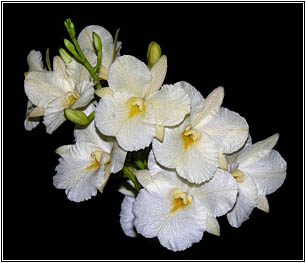 Lpna. Hamlyn’s Masterpiece ‘Phillip Hamilton’ AM/AQ/AOS (Bro. sanguinea aurea ‘Andrew’ AM/AQ/AOS x Lpna. Kingston alba ‘Hamlyn’ AM/AOS) |
The late W.W.G. Moir of Hawaii was the first person to have registered a Broughtonia hybrid, with the Royal Horticultural Society. In the early 1950’s he visited
several countries in the Caribbean and obtained plants of several orchid species
native to the area that he later used for hybridizing. One of the first hybrids
that that he bred was Ctna. Rosy Jewel which was registered in 1956.
It is a hybrid of Broughtonia sanguinea from Jamaica and Cattleya bowringiana from Belize, then Known as British Honduras. Some superb clones of this hybrid
are still present in collections today. They are compact to dwarf plants that
grow well and flower early, in small pots. Many will flower for the first time
in a 2” pot. They tend to produce multiple growths, many flowering on
each new growth, thus producing many inflorescences during the year. The flowers
though comparatively small, open sequentially on the inflorescence, which very
often produces secondary branches, oftentimes after the initial crop of blooms
are produced. The author has flowered Broughtonia hybrids with fifty
four flowers and buds on one inflorescence and with a total of five inflorescences
on a plant grown in a 4.5” pot. |
Though the Broughtonias breed freely with many different species within Laelinae, there are no registered primary hybrids with any of the unifoliateCattleyas
species, the large unifoliate flowered hybrids, or with Rhyncholaelia. Popular primary Broughtonia hybrids therefore have all been made using the bifoliate Cattleyas or species of other genera. These were then used as surrogates for introducing Broughtonia genes into the larger flowered species and hybrids. In general, these crosses produce plants that have larger but fewer blooms than the bifoliate hybrids. In the early years of Broughtonia hybridizing, perhaps the most popular and successful hybrid was Ctna. Keith Roth (Bro. sanguinea x C. bicolor) bred by Fields Orchids of Miami, Florida and registered in 1966. This grex was used to produce many hybrids, that became very popular in the mid 1970’s, during the O.P.E.C. oil crisis, when U.S. growers were searching for plants that flowered often and that did not require a lot of greenhouse space. Ctna. Jamaica Red (Bro. sanguinea x Ctna. Keith Roth), Lctna. Roy Fields (Ctna. Keith Roth x Lc. Mattie Shave) and Stlmra. Kelly (Ctna. Keith Roth x Brassavola nodosa) are still some the best of a long list of hybrids bred from Ctna. Keith Roth, the vast majority of which were unregistered. Its popularity probably led to its downfall. In the 1980’s it was bred to virtually any hybrid or species that would hold a seed pod. The result was a plethora of poor hybrids that very clearly showed their ancestry. There was sameness to many of them, as they tended to be almost all some shade of lavender to reddish purple. This created the stereotype of a Broughtonia hybrid being a little purple orchid. Not all of these hybrids were purple however, as there were hybrids such as Otr. Maili’s Surprise (Ctna. Keith Roth x Blc. Waikiki Gold), that has peachy coloured tones, and others unregistered. In 1979 Stewart’s Orchids of California registered Ctna. Why Not AQ/AOS (Bro. sanguinea x C. aurantiaca). This grex became very popular in later years when H & R Orchids of Hawaii remade the cross and sold many high quality seedlings to enthusiasts. One particular clone, Ctna. Why Not ‘Roundabout’ AM/AOS was particularly outstanding. It is bright red with a large bright yellow disc in the throat. Ctna. Why Not has been used to produce a large number of very attractive hybrids, noted for their floriferousness, good substance, early flowering and ease of culture. Notable among these are Ctna. Henry Wan (Bro. negrilensis x Ctna. Why Not), Ctna. Cosmo-sanguine (Broughtonia sanguinea x Ctna. Why Not), Ctna. Starrlyn (Ctna. Capri x Ctna. Why Not), Lctna. Ernest Cromwell (Lctna. Dal’s Toy x Ctna. Why Not), Osmt. Richard Fulford (Lpna. Kingston x Ctna. Why Not), Hknsa. Keepsake (Slc. Precious Stones x Ctna. Why Not) and Smbctna. Jamaica Fire (Schom. brysiana x Ctna. Why Not). All of these hybrids are notable for their bright red and yellow tones and for their floriferousness. To date very few white or yellow hybrids have been produced. One of the first and certainly the most popular of the white Broughtonia hybrids is Ctna. Maui Maid (Bro. sanguinea x C. Hawaiian Variable). Some of the notable modern white hybrids include Osmt. Jamaica Love alba (Ctna. Orglade’s Little Lover x Lpna. Kingston alba), Lpna. Hamlyn’s Masterpiece AQ/AOS (Bro. sanguinea aurea x Lpna. Kingston alba, Ctna. Jamaica Joy alba ‘Hamlyn’ HCC/AOS (Bro. sanguinea var aurea x Ctna. Capri) and Ctna. Jamaica Gypsy alba (Bro. negrilensis alba x C. bowringiana alba). There are some new hybrids using the yellow, peloric form of Broughtonia sanguinea. Notable among these are Lpna. Hamlyn’s Masterpiece (aurea forms), Ctna. Jamaica Joy var aurea, Currently, a number of very attractive Broughtonia hybrids are to be found in the marketplace. Some of these are hybrids of Ctna. Capri ‘Lea’ AM/AOS (Ctna. Jamaica Red x C. intermedia var aquinii) and have very attractive flaring or shading on the petals. A good example of this type is Ctna. Quest’s Millennium (Ctna. Jamaica Red x Ctna. Capri). Others have Lctna. Peggy-San ‘Cynosure’ AM/AOS as an ancestor with more vivid flaring on the petals. One such is the very striking Hknsa. Sogo Doll (Lctna. Peggy San x Slc. Katsy Noda). Ctna. Orglade’s Little Lover has produced many attractive hybrids including albas. Among these is Ctna. Jamaica Gem (Ctna. Orglade’s Little Lover x Ctna. Capri) a hybrid with several clones that consistently produce over fifteen flowers on one inflorescence while bearing multiple inflorescences. Lpna. Kingston alba ‘Hamlyn’ AM/AOS (Bro. sanguinea aurea x Lps. domingensis alba) was bred by the late William Osment of Cuba and Hollywood, Florida. These are vigorous growing plants that flower once per year, producing very attractive pure white flowers on upright inflorescences. Mr. Osment would only sell me one small 2” plant at a time and so I found it necessary to pay several visits to his nursery, so as to be able to purchase a number of seedlings. This clone has produced many very attractive hybrids, in a variety of colors, varying from white to yellows to lavenders and purples. Two grexes have to date been recognized by American Orchid Society judges with the prestigious Award of Quality. These are Osmt. Elizabeth Hamilton (Lpna. Kingston alba x Ctna. Maui Maid alba) and Lpna. Hamlyn’s Masterpiece (Bro. sanguinea aurea x Lpna. Kingston alba). Many of our modern Broughtonia hybrids have been bred from a peloric form of the species – Broughtonia sanguinea var aurea ‘Hamlyn’ AM/AQ/AOS. This clone consistently produces offspring in a variety of colors with very wide, often overlapping petals, comparatively wide sepals and large full lips many with outstanding form. It is from a grex that was recognized with an Award of Quality, and was used in turn, to produce another grex that also received and Award of Quality from the American Orchid Society. Whither the future of Broughtonia hybridizing? We should not only aim to produce hybrids in a greater variety of colors but ones that have blooms better displayed on the inflorescence. More hybrids need to be made using the very attractive though difficult to find species like Ctps. lindenii and Ctps. ortgiesiana. Ctps. ortgiesiana has the potential to produce flowers that are better displayed on the inflorescence, with better spacing between the flowers, but tends to have weak inflorescences. Tetraploid forms of this species should help to correct this problem. Broughtonia hybridizing is progressing and no longer in its infancy. There is still much to be done and many new hybrids to be made. |
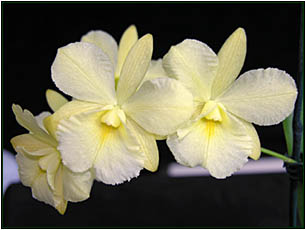 |
 |
Ctna. Jamaica
Joy alba ‘Hamlyn’ HCC/AOS |
Ctna. Jamaica Gypsy ‘Hamlyn’ (Bro. negrilensis alba x C. bowringiana alba) |
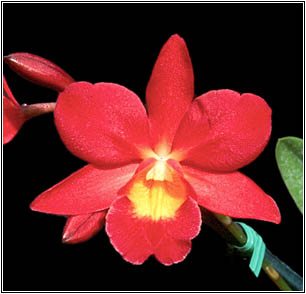 |
 |
Smbctna. Jamaica Fire |
Broughtonia sanguinea var aurea ‘Hamlyn’
AM/AQ/AOS. |
Other Hybrids |
|
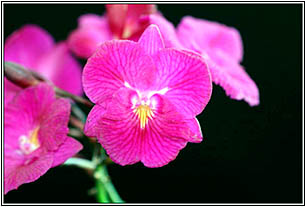 |
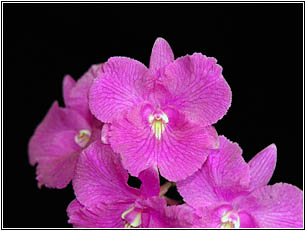 |
Ctna. Jamaica Joy 'Claudia' |
Ctna. Joy 'Jay' |
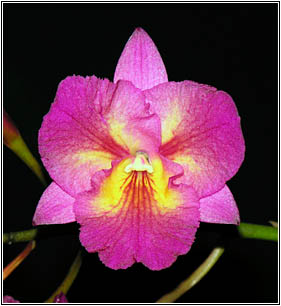 |
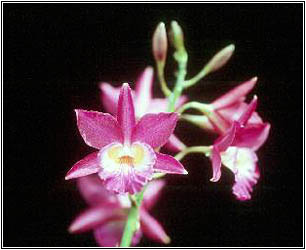 |
Osmt. Ernest Cromwell |
Smbna. Elaine Fisher 'Hamlyn' HCC-AOS |
|